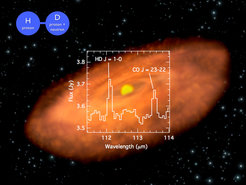Protoplanetary disk around TW Hydrae outweighs previous estimates

The mass of protoplanetary disk around TW Hydrae was determined to be about 50 Jupiter masses, which means that a complex planetary system could develop in the future.
The star TW Hydrae is an interesting object for astronomers studying planet formation: The young star with a mass similar to that of our Sun is surrounded by a protoplanetary disk where gas, dust and grains could clump together to eventually form planets similar to those of our Solar System. But even though TW Hydrae is relatively close – it has a distance of only 176 light-years from Earth – it has been very difficult to measure one key property: the total mass of its protoplanetary disk. The main component of the disk, molecular hydrogen, hardly emits any radiation, so it cannot be measured directly. The mass of the disk, however, is crucial in determining how many and what kinds of planets can be expected to form.
Previous mass determinations used other molecules (e.g. CO) or dust particles as tracers and were heavily dependent on model assumptions. The new measurements now use a special variety of hydrogen molecules, so called heavy hydrogen. This consists of one normal hydrogen atom (where the nucleus is a single proton) and one deuterium atom (with an additional neutron in the nucleus). The relative abundance of deuterium and hydrogen is extremely well known from measurements in our cosmic neighbourhood and this “heavy molecular hydrogen” or “hydrogen deuteride” emits significant infrared radiation related to the molecule’s rotation.

The asymmetric structure of hydrogen deuteride results in a small dipole moment of the molecule, causing much stronger emission than from the more abundant but symmetric hydrogen molecules. The main spectral line of HD, which was used to determine the mass of the disk, is indicated, it lies is the far-infrared part of the electromagnetic spectrum. A line of the CO molecule is also detected.
And this radiation was now measured using ESA’s Herschel space telescope. “This is the first time we have observed the emission from heavy molecular hydrogen in a protoplanetary disk, and just the second time we have detected this signal in space,” notes co-author Ewine van Dishoeck from the University of Leiden, The Netherlands, and MPE Garching. “The great sensitivity of Herschel-PACS was fundamental to this discovery,” she adds.
The observation sets a lower limit for the protoplanetary disk mass at about 50 Jupiter masses, with an uncertainty ten times smaller than previous results. While TW Hydrae is estimated to be relatively old for a stellar system with a disk (between 3 and 10 million years), this shows that there is still ample of matter in the disk to form a planetary system larger than our own (which arose from a much lighter disk).
Notes:
The Herschel observations were performed as part of the Herschel Open Time Programme “A New Method to Determine the Gas Mass in Protoplanetary Disks” led by Edwin Bergin. The observations used Herschel’s instrument PACS (“Photodetector Array Camera & Spectrometer”), a combination of camera and spectrograph for wavelengths between 57 and 210 µm.
Herschel is an ESA space observatory with science instruments provided by European-led Principal Investigator consortia and with important participation from NASA. PACS has been developed by a consortium of institutes led by Albrecht Poglitsch at MPE (Germany) and including: UVIE (Austria); KU Leuven, CSL, IMEC (Belgium); CEA, LAM (France); MPIA (Germany); INAF-IFSI/OAA/OAP/OAT, LENS, SISSA (Italy); IAC (Spain). This development has been supported by the funding agencies BMVIT (Austria), ESA-PRODEX (Belgium), CEA/CNES (France), DLR (Germany), ASI/INAF (Italy), and CICYT/MCYT (Spain).













